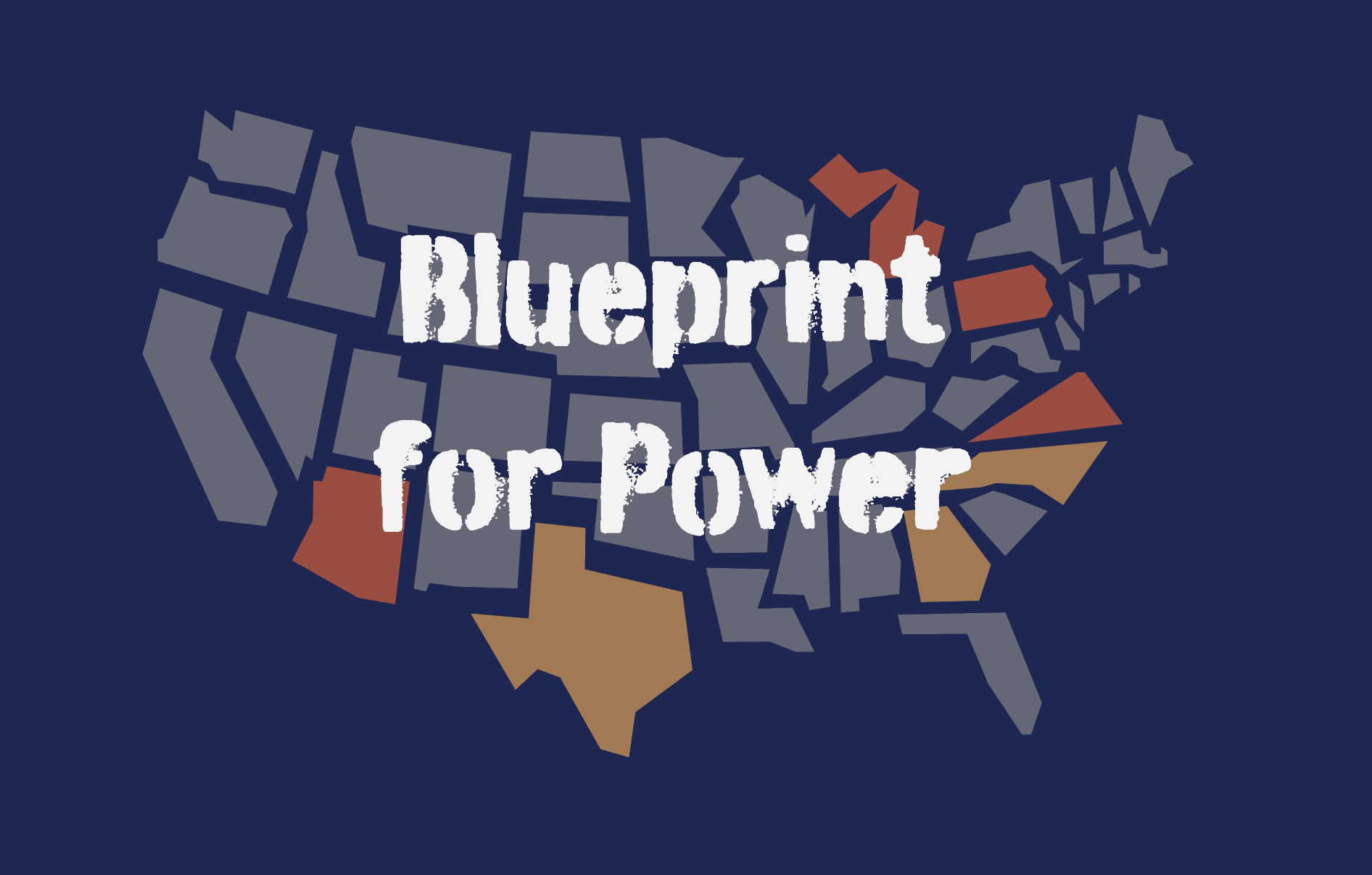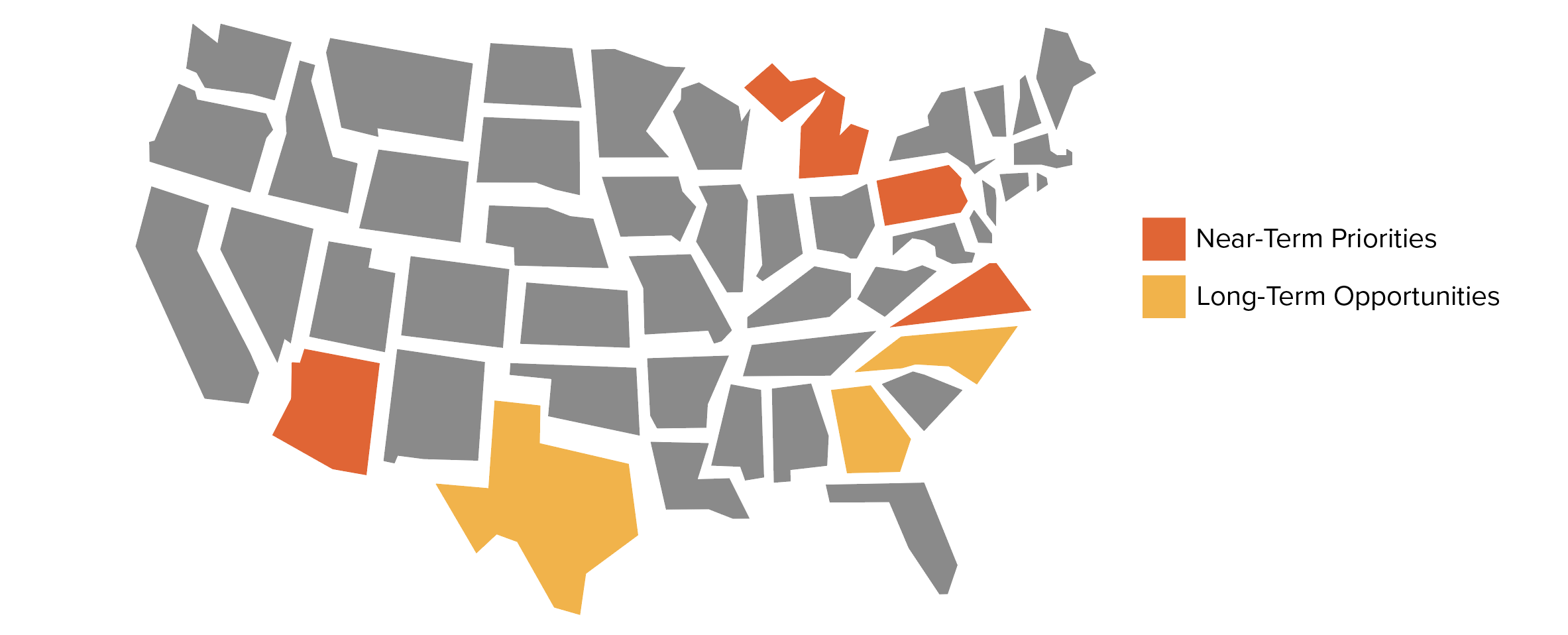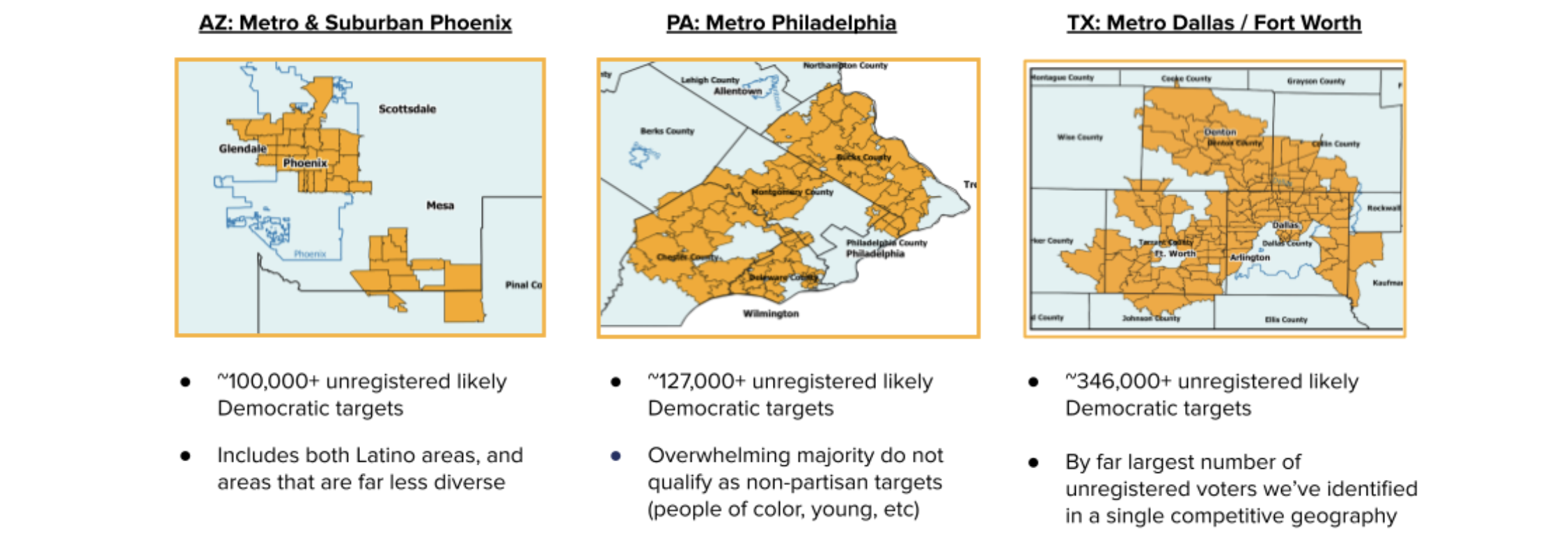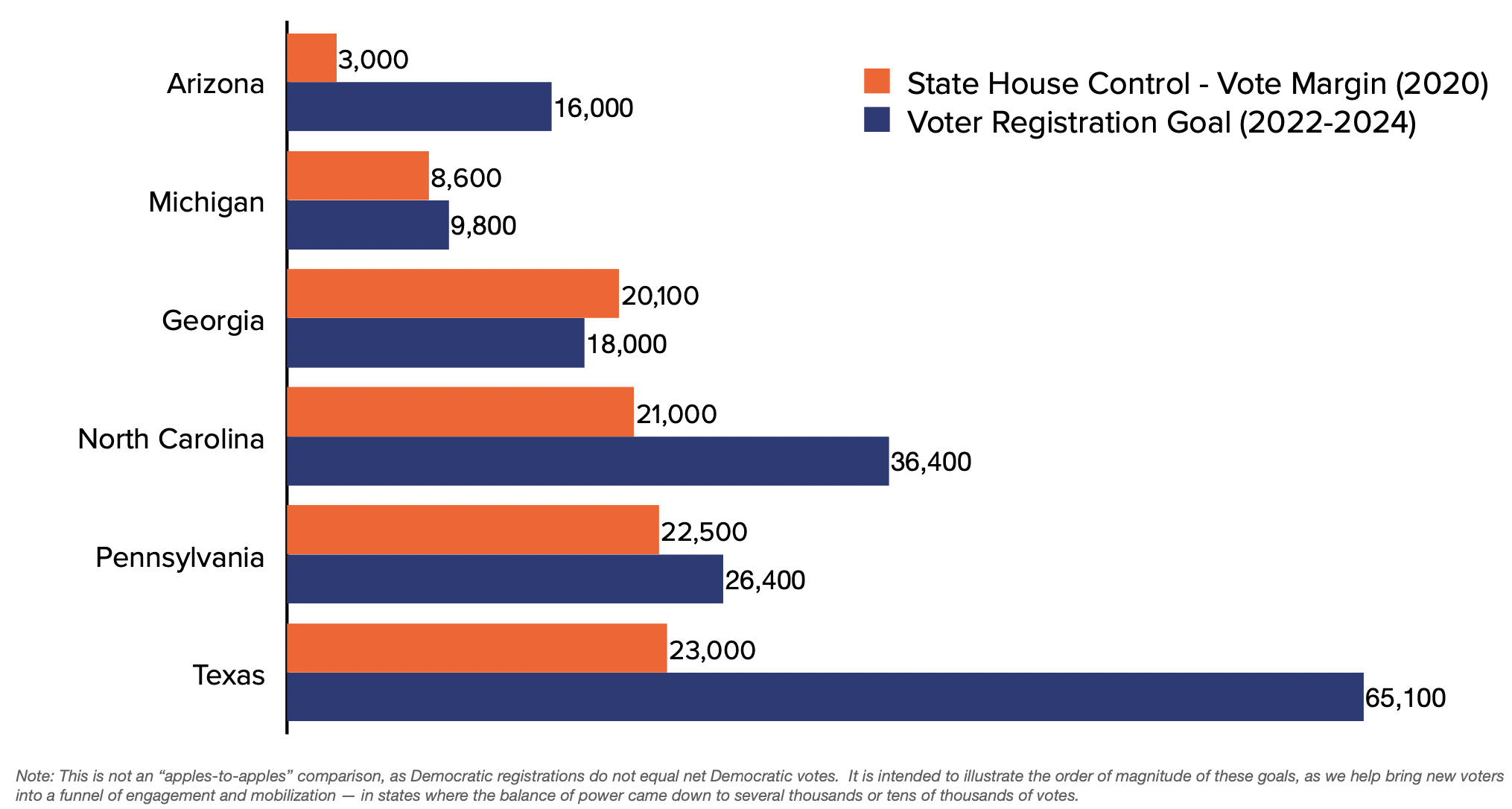
Context & Purpose
The purpose of this concept note is to outline Forward Majority’s strategy to accelerate state legislative power to protect democracy. Overall, this approach is designed to cut to the heart of voter disenfranchisement through voter suppression, gerrymandering, and undermining of election authority – to ensure democratically elected, representative leadership in states that drive national power. Since our founding in 2017, Forward Majority has been leading the fight back to power in state legislatures, mobilizing more than $50M and helping to flip 65 seats and 2 chambers. What follows is a summary of the electoral outlook through 2030, including states that will be essential to national power, and a deep dive into the three pillars of our model designed to seed the ground and prepare to capture opportunity in key state legislatures over the decade ahead.
State Legislatures Are Ground Zero in the Fight for Democracy
Across the country, Republican-controlled state legislatures are waging a systematic assault on voting rights, democratic norms, and fair elections. This is the frontline of the fight for democracy as the alarm bells are blaring louder by the day. One need look no farther than Republicans’ embrace of the “independent state legislature” doctrine, allowing legislatures to overturn election results, to appreciate the value of winning power in key chambers. As Steve Bannon asserted, “state legislatures are the center of gravity.”
Democrats’ failure to invest effectively in state legislative power over the past decade is a root driver of this crisis. Fundamentally, there are three deficits in the current investment model: (1) an overwhelming focus on federal power and races higher on the ballot; (2) short-termism, focused on individual election cycles — and often just the final two months, failing to engage with key voters the other 22 months of a campaign cycle; (3) it has overlooked voter registration and base-building in key suburban and exurban geographies where state legislative power is won or lost.
Reclaiming critical footholds of power in state legislatures requires a multi-cycle, long term strategy to address these deficiencies and prepare Democrats to win in the years ahead.
An Electoral Outlook with New Opportunities and Challenges
To inform our strategy, we undertook a robust quantitative analysis to understand how the electoral map is likely to evolve through 2030. The bottom line: the outlook for Democrats is precarious: good years deliver wins with razor-thin margins, while bad years are devastating routs. As a result, we will need to fight for near-term gains, while also making longer term investments to secure power.
A Sliver of States Drive National Power: This analysis reinforced the importance of building legislative power in PA, MI, AZ, TX, NC, VA and GA. Except for GA, we invested in each of these states in 2018 and/or 2020 cycles, and have existing relationships, experience and knowledge.
The Media’s Got It Wrong: The media narrative and pundits would have you believe that Republicans have gerrymandered themselves into a decade of power in state legislatures. This sentiment would have one believe that it is not even worth trying to win power at this stage. Luckily, that simply isn’t true when one looks at the data.
Our 2021-2030 Portfolio: As illustrated below, there are newly competitive legislative chambers that present urgent, near-term opportunities where Republicans were unable to gerrymander maps for the first time in a decade. There are also key, long-term imperatives in the sunbelt, where gerrymanders will be litigated. But, equally important, these gerrymanders have been drawn with certain design choices. Our job is to understand the vulnerabilities of these design choices – and work to exploit them over time. We saw in the sunbelt this past decade that gerrymanders decay with population growth and change; we are focused on accelerating that decay.
- Urgent, near-term opportunities: In the 2022/2024 cycles, we anticipate majority plays in AZ, PA, MI, and VA. Legislative power in these states will be crucial to securing a fair presidential election in 2024. We expect these legislatures will need continued investment to build / defend power through 2030.
- Longer-term imperatives:In states where we see gerrymandered maps — TX, GA, NC — a longer-term approach is essential to accelerate our path to power, even as maps are litigated and gerrymanders decay. TX remains a cornerstone of our work, as one of the most populous and consequential emerging battleground states.

Figure 1 – portfolio for state legislative power (2021-2030)
Our Model: Three Accelerants to Build Power
Our Moonshot: Over the next ten years, our goal is to flip competitive state legislative chambers in our target states. Our investments aim to increase the probability of chamber-flips, and to accelerate the timeline of progress. Democrats are only locked out of power in the decade ahead if we collectively take no action. As outlined below, there are key investments to make now, through a multi-cycle lens, which address key deficiencies and gaps to raise the floor of Democratic performance.
Expanded Model — Three Accelerants: We will focus on three core pillars of work, all in strategically valuable, chronically neglected areas of the state legislative battleground: (I) shaping the electorate by investing and innovating in voter registration in neglected geographies through a state legislative lens; (II) engaging voters year-round to build a local narrative and brand with key audiences, rather than ceding the message war to Republicans for 20 out of every 24-month election cycle; and (III) doubling down on our muscular campaigns at the legislative level, and committing to them for the long term. These are key parts of the voter life cycle and funnel of engagement; below we outline the case for each.
I. Voter Registration in Neglected Geographies
Untapped Opportunity: Voter registration efforts have been a tremendous success and key piece of Democrats’ victories over the past decade. However, the majority of existing efforts don’t reach frontline geographies (suburbs, exurbs) — where state legislative majorities are won or lost. This is a function of how the voter registration space has been funded and incentivized to date, with 501c3 non-partisan targeting and tools, and a relentless focus on lowest cost per registration. This has kept the investment concentrated primarily in base areas. Cities and college campuses have gotten bluer, but there is untapped opportunity in the core state legislative battleground. For example, in Arizona, all of the battleground districts were outside of Phoenix proper and in suburban cities like Glendale, Chandler, or Peoria. The same is true in Texas where the vast majority of targets were not in Dallas or Houston but in suburbs like Plano, Denton, Fort Worth or Sugar Land.
We’ve identified ~2 million unregistered likely Democratic voters in this target terrain:– suburban areas of TX, AZ, PA, NC, MI, and GA. This is an incredibly important foundational component of our multi-cycle strategy going forward — one that is not being systematically pursued through a state legislative lens — and which adds marginal value up and down the ballot. This just scratches the surface on the opportunity in these geographies.

Figure 2 – counts of likely democratic unregistered voters across 17 key metro areas
Opportunity lies in 17 suburban / exurban geographies of 6 states: Above is a summary of counts of likely Democratic unregistered voters in the suburban and exurban areas in our target states (i.e., Dallas / Fort Worth, Houston, San Antonio, Raleigh, Charlotte, Philadelphia, Pittsburgh, Atlanta, Phoenix, Detroit). We identified these by zip code in areas likely to be competitive in the next decade or to be incorporated into a competitive state legislative district. Once district lines are finalized, this targeting can be further refined, but these represent our best current understanding of the competitive landscape. Examples of these geographies are described below.

Figure 3 – example geographies
Capturing this Opportunity Requires a Radical Departure from Existing Efforts: The predominance of 501c3 funding and relentless focus on low cost have constrained Democrats’ ability to tap this opportunity. To shape the electorate and overcome the disadvantage of gerrymandering and geography, we must (1) use partisan (501c4 / PAC) funding, and a sharply partisan lens (targeting, signaling, messaging) to target Democratic voters on the narrow battleground map that will most effectively impact state legislative outcomes; (2) have a higher tolerance for cost that recognizes the value of these prospective voters; and (3) the ability to rapidly experiment, innovate and learn given there is little existing evidence or specialized experience. To tap into this opportunity, we will continue to partner with the Center for Voter Information to pursue a mail strategy, and will expand into novel approaches via digital and field, in partnership with key experts and local/national partners.
Significant Marginal Impact: Using a combination of mail plus experimental field programs, our proposed voter registration efforts would collect ~240,000 likely-Democratic registrations in key state legislative battlegrounds by 2024. As illustrated below, our goal through field programs alone in AZ through 2024 is to register ~14,500 Democratic voters in suburban Phoenix, and the balance of power in the State House was decided by ~3,000 votes in 2020. Notably, President Biden’s margin in AZ was just 11,000 votes. In TX, our goal is to register ~105,000 voters in the suburbs of Dallas, Houston and San Antonio, and 2020 TX State House control came down to ~23,000 votes. The situation is similar in PA, NC, MI, and GA, all states that decide national power in races that come down to tens of thousands of votes.

Figure 4 – example voter registration goals in context (2021-2024)
II. Long-Term Narrative and Brand Development with Key Audiences
Success in Legislative Races Requires Shifting Perceptions of the Local Party Brand. An estimated 90% of voters choose parties rather than candidates. This is especially true in low-salience, down-ballot races, amongst key audiences. There is a clear wedge to drive, with key segments of voters viewing local party brands distinct from national brands. For example, low-information voters and ticket-splitters who were outraged by Trump, fail to see their local, extremist legislators in the same light. This insight was reinforced by our post-election research focused on ticket splitters, a small but critical cohort of voters in must-win legislative races. Candidates’ communications are limited, and party perceptions account for much of voters’ decision-making. While shifting party affiliation might seem like a difficult task in this highly partisan environment, with key groups of voters, it is happening routinely in a dramatic way.
An Out-of-Date Playbook Can’t Compete with Right-Wing Propaganda: The traditional playbook has regularly failed to meet the complexity of our current information and media environment. Typical campaign communications identify the most popular policies, then try to sell them to voters in the closing month(s) of the election cycle. Meanwhile, the vast majority of ordinary voters spend only moments making their vote choice, a decision dominated by existing narratives about the parties, increasingly influenced by right-wing media, disinformation and propaganda.
Opportunity to Cut Through by Building Local Narrative and Brand: To counter this, particularly in Republican trifecta states, Democrats need a local communications operation that is similarly relentless, but more astute and opportunistic. Going forward, as we continue to move new voters into the electorate — and long before campaign season starts — we must help to reshape local political narratives in our targeted districts. This includes accountability communication that shines a light on the track record of incumbent Republicans on unpopular legislation, builds the local Democratic brand, dents the GOP brand, and highlights how state legislatures impact people’s lives. Democrats have been over-built on targeting, and under-built on content. This means we know who to communicate with, but far less on how to most effectively communicate to move sentiment and achieve electoral goals. What’s needed is cutting-edge approaches to content sourcing, testing, and dissemination, leveraging earned and paid media. Notably, this local brand cultivation and strategic communication has the potential to influence not only local races, but to seed from the ground-up winning narratives and shifting party affinity that can influence the broader electorate.
III. Muscular Campaigns
Difference-Maker in Close Races: Where we have opportunities to win competitive races, our campaign interventions can be decisive in generating Democratic margin and helping to win key seats. We are doubling down on our campaign programs, continuing to focus on “undervalued,” under-resourced races that lie in the path to Democratic majorities.
At the Cutting Edge: Through extensive experimentation and testing, we know our programs to be some of the most effective in the field at generating Democratic margin. We will continue to invest in top campaign talent, data and innovation to drive performance, win key races — and take control of chambers. This includes building analytical approaches to optimize investments, and experimentation and testing to build the sharpest state legislative playbook.
Evidence-Based Investments: Across the randomized control trials (RCTs) assessing our turnout and persuasion tactics, we consistently out-performed. For example, our digital persuasion programs generated an estimated +2.5 points of Democratic margin in targeted races (the net effect of most persuasion programs is 0.) We also developed a range of innovative programs, including VetsForward, a “deep canvass” field program with a team of military veterans. We will continue to innovate, experiment, test and help build the evidence base on Democrats’ campaign playbook to win legislative races.
No Time to Waste
This is a Fight for the Survival of American Democracy and Our Most Fundamental Rights: In the tumultuous decade ahead, we must fight for every foothold of power that helps secure democracy. It will not be easy; there will be wins and losses along the way. But, an under-funded, long neglected landscape is also a landscape with latent opportunity. With concerted strategic action and investment, together we have a chance to bend the trajectory of history and protect democracy for generations to come.